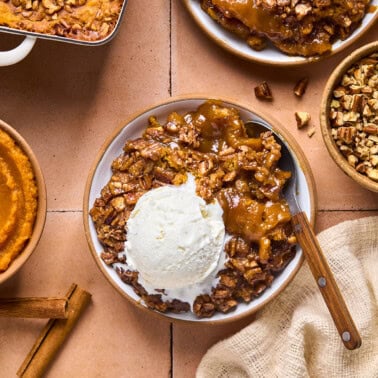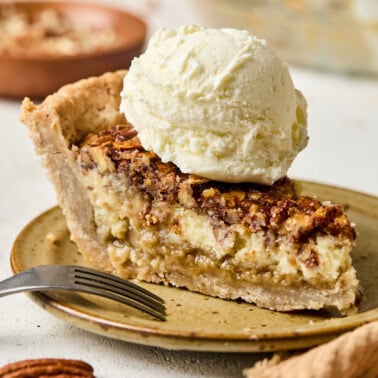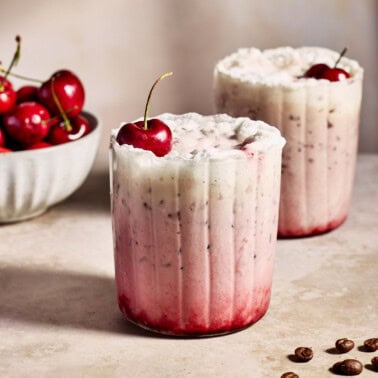How to Make the Perfect Gluten-Free Pie Crust Recipe
Published Nov 19, 2024
This post may contain affiliate links. Please read our disclosure policy.
Hey y’all! Crafting the perfect homemade gluten-free pie crust can be a delightful journey, and I’m here to guide you every step of the way. Let’s dive into creating a crust that’s not only as buttery and flaky as the classic, but also versatile enough for all your pie-making adventures.

Table of Contents
Why You’ll Love This Gluten-Free Pie Crust Recipe
This gluten-free pie crust recipe is everything you want in a crust and more. It took a few trial runs in my kitchen with my little ones eager to taste-test and let me tell you– this final version is everything and more! (If your kids love to bake too, add my gluten-free sugar cookies to your Holiday calendar!)
Delicate, golden layers that melt in your mouth with each forkful. It’s buttery, crisp, and light—the kind of crust that’s hard to resist, whether it’s filled with a rich pecan pie recipe, a savory pot pie, or even mini pumpkin pie tarts! As it bakes, the edges turn a lovely shade of deep golden brown, giving the crust a beautifully rustic look and feel.
This perfect pie crust holds up beautifully, with a flaky texture that doesn’t crumble under fillings but has a delicate crunch that adds just the right touch to every slice.
Ingredient Notes

For Single-Crust Pies
- Gluten-Free Flour Blend: I use King Arthur’s Measure for Measure flour blend, which provides a sturdy structure without gluten and still allows for a tender, easy-to-roll dough. This blend holds up well in baking, making it ideal for achieving that classic pie crust look and feel. If you use another blend, make sure it has xanthan gum for structure and texture. Another popular option is Bob’s Red Mill.
- Sugar: Just a bit to add subtle sweetness.
- Cold Salted Butter: Cold butter is key to flakiness.
- Apple Cider Vinegar: This ingredient may seem surprising, but it’s here for good reason. The acidity helps relax the gluten-free dough, making it more pliable and less likely to crack as you roll it out.
- Cold Water: Adding cold water slowly prevents the dough from becoming too sticky.
For a Double-Crust Pie
- Gluten-Free Flour: For larger pies, extra decoration, or double-crust recipes.
- Sugar: Slightly more for a double crust.
- Cold Salted Butter: Double the butter for double the flakiness.
- Apple Cider Vinegar: Adds a hint of tanginess and helps with texture.
- Cold Water: Add slowly until the dough holds together.
See the printable recipe card below for exact ingredient amounts.
Recipe Customizations
- Vegan Option: Substitute the butter with cold, vegan butter (I recommend a plant-based butter that comes in stick form). This will keep the crust flaky without any dairy.
- Savory Crust Variation: For a savory pie or quiche, skip the sugar altogether or add a pinch of garlic powder and dried herbs for an extra layer of flavor.
Step-by-Step Instructions

Step 1: Combine Dry Ingredients: In a food processor or mixing bowl, add the gluten-free flour and sugar. Pulse or whisk to combine and create an even base for the butter.

Step 2: Add Cold Butter: Cut the cold, salted butter into small cubes. Add the butter to the flour mixture and pulse (or use a pastry cutter) until it resembles coarse crumbs with pea-sized pieces of butter throughout.

Step 3: Add Vinegar and Water: Drizzle in the apple cider vinegar. Slowly add cold water, 1 tablespoon at a time, pulsing or stirring after each addition. Add just enough water for the dough to hold together when pressed (usually about ¼–⅓ cup for a single crust).

Step 4: Form the Dough: Turn the dough out onto a piece of plastic wrap, gather it into a ball, and flatten it into a disc. Wrap tightly and refrigerate for at least 30 minutes (or up to 1 hour) to let it firm up.

Step 5: Roll Out the Dough: Once chilled, place the dough between two pieces of parchment paper or on a floured surface. With a rolling pin, roll it out into a circle about ⅛ inch thick and 1–2 inches larger than your pie pan. Tip: Use any scraps left over for decoration or use the double crust option to make a lattice top or other more extensive decor.

Step 6: Transfer to Pie Pan: Gently place the dough into your pie plate/pie pan, pressing it into the bottom and sides. Trim any excess and shape or crimp the edges as desired.

Step 7: Chill and Bake: For a pre-baked crust, chill the shaped crust in the pie pan for 10–15 minutes. Prick the bottom with a fork (or follow your recipe’s specific instructions) and bake according to your recipe.

Step 8: Blind Bake for Filled Pies: Line the crust with parchment paper or foil and add dried beans or rice, filling halfway up the sides. Bake at 375°F (190°C) for 15–20 minutes or until the edges turn golden. Remove the beans or rice, and bake a bit longer if needed.
Expert Tips for the Best Gluten-Free Pie Crust
- Use Very Cold Butter: Cold butter is essential for a flaky texture. Keep it in the fridge right up until you’re ready to cut it in.
- Add Water Gradually: Too much water makes a sticky dough, so add it slowly. The dough should hold together when pressed but shouldn’t be wet.
- Chilling the Dough: Chilling isn’t just for ease of rolling—it firms up the butter and makes for a flakier crust. This step is especially crucial for gluten-free baking, where the dough’s structure can be a bit looser.
- Roll Between Parchment Paper: Gluten-free dough can be more delicate, so parchment makes rolling and transferring easier.
- Handling Sticky Dough: If your dough feels sticky, add a light dusting of gluten-free flour as you roll it out. Rolling between two sheets of parchment paper also helps prevent sticking, making it easier to transfer to the pie pan.
- Preventing Cracks: Because gluten-free dough can be more delicate, rolling it between parchment paper helps keep it intact. If cracks do appear, press them back together gently with your fingers or use a touch of cold water as “glue.”

Serving and Storage Tips
- Serving: This gluten-free crust works for any pie! Add sweet fillings like apple or pumpkin for dessert, or use it for savory quiches and pot pies.
- Storage: Store unbaked pie dough in the fridge for up to 2 days or freeze it for up to 3 months. Wrap tightly in plastic and place in a freezer-safe bag. When ready to use, let it thaw overnight in the fridge before rolling out.
Recipe FAQs
Yes! You can make the dough up to 2 days ahead and keep it in the fridge. If you’re making it further in advance, freeze it for up to 3 months and thaw in the fridge before rolling.
No worries! Use a pastry cutter or your hands to cut the butter into the flour until the mixture resembles coarse crumbs.
Blind baking (baking the crust without filling) can help keep your pie from getting soggy if you’re making a custard or fruit pie. Just prick the crust with a fork, cover it with parchment paper, and add pie weights or dried beans to keep it from puffing up as it bakes.
Yes! You can skip the sugar if making a savory pie, or leave it in if you prefer. This crust pairs well with quiches, savory galettes, and pot pies.
Easy Dessert Recipes
If you love this recipe, please give it a star rating and leave a comment below! Follow me on Pinterest, Facebook, and Instagram for more!
Follow on Instagram


How to Make the Perfect Gluten-Free Pie Crust Recipe
Ingredients
Single Crust
- 1 1/2 cups gluten-free flour 180 grams King Arthur’s Measure for Measure
- 1 1/2 tbsp sugar
- ¼ cup cold water add more as needed (1 tbsp at a time)
- 8 tbsp cold salted butter 1 stick
- ½ tsp apple cider vinegar
Double Crust
- 2 1/2 cups gluten-free flour 300 grams King Arthur’s Measure for Measure
- 2 tbsp sugar
- 1/2 cup cold water add more as needed (1 tbsp at a time)
- 1 cup cold salted butter, cut into small cubes 2 sticks
- 1 tsp apple cider vinegar
Instructions
- Combine Dry Ingredients: In a food processor or mixing bowl, add the gluten-free flour and sugar. Pulse or whisk to combine.
- Add Cold Butter: Cut the cold, salted butter into small cubes. Add it to the flour mixture and pulse (or use a pastry cutter) until the mixture resembles coarse crumbs with pea-sized pieces of butter throughout.
- Add Vinegar and Water: Drizzle in the apple cider vinegar. Then, gradually add the cold water, 1 tablespoon at a time, pulsing or stirring gently after each addition. Use just enough water for the dough to hold together when pressed.
- Form Dough: Turn the dough out onto a piece of plastic wrap. Gather it into a ball, then flatten it into a disc. Wrap it tightly in the plastic wrap and refrigerate for at least 30 minutes (or up to 1 hour) to let it firm up.
- Roll Out Dough: Once chilled, place the dough between two pieces of parchment paper or on a floured surface. Roll it out into a circle about 1/8 inch thick and 1–2 inches larger than your pie pan.
- Transfer to Pie Pan: Carefully place the dough into your pie pan, pressing gently to fit it into the bottom and sides. Trim any excess dough around the edges and crimp or shape the edge as desired.
- Chill and Bake: If the recipe calls for a pre-baked crust, chill the shaped crust in the pie pan for 10–15 minutes. Then, prick the bottom with a fork OR don’t prick the bottom (always go according to your recipe's instructions) Bake according to the recipes instructions.
- Line the Crust: Cut a piece of parchment paper or aluminum foil large enough to cover the crust and extend up the sides. Gently press it down onto the crust, covering the bottom and edges.
- Add the Beans: Pour dried beans (or rice) onto the parchment or foil, filling the crust about halfway up the sides. Distribute the beans evenly so they press the crust down and hold it in
- Blind Bake: Bake the crust with the beans in the oven according to the recipe’s instructions—usually for 15-20 minutes at 375°F (190°C), or until the edges begin to turn golden.Do show the baked crust in the step-by-step.
Notes
-
- Double Crust: I always use a double crust when I make pies to ensure I have enough to work with and can create pretty edges. Freeze any leftovers.
- Use Very Cold Butter: Cold butter is essential for a flaky texture. Keep it in the fridge right up until you’re ready to cut it in.
-
- Add Water Gradually: Too much water makes a sticky dough, so add it slowly. The dough should hold together when pressed but shouldn’t be wet.
-
- Chilling the Dough: Chilling isn’t just for ease of rolling—it firms up the butter and makes for a flakier crust. This step is especially crucial for gluten-free baking, where the dough’s structure can be a bit looser.
-
- Roll Between Parchment Paper: Gluten-free dough can be more delicate, so parchment makes rolling and transferring easier.
-
- Handling Sticky Dough: If your dough feels sticky, add a light dusting of gluten-free flour as you roll it out. Rolling between two sheets of parchment paper also helps prevent sticking, making it easier to transfer to the pie pan.
-
- Preventing Cracks: Because gluten-free dough can be more delicate, rolling it between parchment paper helps keep it intact. If cracks do appear, press them back together gently with your fingers or use a touch of cold water as “glue.”
Nutrition
Nutrition information is automatically calculated, so should only be used as an approximation.



















